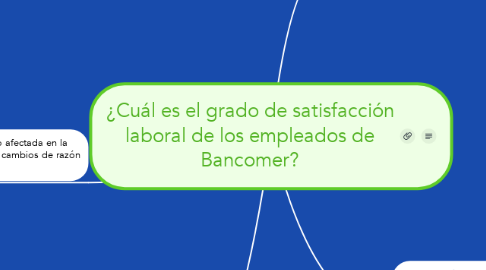
1. Instrumentos En la investigación se utiliza como instrumentos el cuestionario el cual está estructurado con preguntas cerradas, las cuales van dirigidas al personal BANCOMER.
2. La Banca Privada, se ha visto afectada en la última década, debido a los cambios de razón social de estas instituciones.
2.1. Aspecto organizativo, metodológico y operativo que se relacionan con el desempeño laboral y el ambiente de trabajo.
2.2. Es el medio ambiente humano y físico en el que se desarrollan las actividades laborales de una empresa.
2.3. Cumplimiento de metas de trabajo en lo administrativo técnico normativo y alta productividad
2.4. Aplicación de lineamientos de trabajo administrativo técnico normativo y alta productividad
2.5. Indicadores
2.5.1. Relaciones interpersonales.
2.5.2. Cumplimiento de funciones
2.5.3. Condiciones de infraestructura
2.5.4. Incentivos y Remuneraciones
2.5.5. Metas alcanzadas
2.5.6. Compromiso al trabajo
2.5.7. Satisfacción laboral y Motivación
3. Se considera conveniente ejecutar lo siguiente para tener claro algunos aspectos que pueden estar generando este problema
3.1. Cuáles son las fuentes de conflicto que puedan generar resultados inadecuados para los empleados de BANCOMER.
3.2. El comportamiento laboral de los empleados de BANCOMER se percibe un ambiente favorable o desfavorable entre los diferentes departamentos
3.3. Habrán empleados con sobrecarga laboral (metas) que los empleados enfrentan día a día dentro de BANCOMER.
3.4. Que está generando que los empleados estén en insatisfacción en sus puestos de trabajo será por parte de la organización o serán los empleados.
4. Elementos típicos que contribuyen a un clima laboral favorable.
4.1. Calidad de liderazgo.
4.1.1. Situational Analysis / Drivers
4.1.1.1. What is driving us to do this?
4.1.1.2. SWOT Analysis
4.1.1.2.1. Strengths
4.1.1.2.2. Weaknesses
4.1.1.2.3. Opportunities
4.1.1.2.4. Threats
4.1.1.3. Customer Findings - What have we learned from customers?
4.1.2. Competitive Analysis
4.1.2.1. Do we have competitors and threats in these target markets with the proposed offerings?
4.1.2.2. What are our competitors doing and how are they positioning?
4.1.2.3. How do we position against each competitor?
4.1.3. Target Customer(s)
4.1.3.1. Buyer Profile
4.1.3.1.1. Title
4.1.3.1.2. Industry
4.1.3.1.3. Geography
4.1.3.1.4. Business Size
4.1.3.2. Influencer Profile
4.1.3.3. User Profile
4.1.3.4. What do customers want and need?
4.1.3.5. What business problems do each of these customers have?
4.1.4. Customer Segmentation
4.1.4.1. Which customers or sets of customers do we sell to?
4.1.4.2. What are the target market segments that we want to go after?
4.1.4.3. What are the distinct problems for each segment of the market?
4.1.5. Total Available Market
4.1.5.1. New Prospects
4.1.5.1.1. How much of each target segment have we penetrated?
4.1.5.1.2. How much opportunity is available in each target segment?
4.1.5.2. Existing Customers
4.1.5.2.1. Can we up-sell existing customers?
4.2. Nivel de confianza
4.2.1. Service Offer
4.2.1.1. What are we selling?
4.2.1.2. Product Definition
4.2.1.3. Pricing
4.2.1.4. Packaging
4.2.1.5. Positioning
4.2.2. Value Proposition
4.2.2.1. What is the Value Proposition to the Customer?
4.2.2.2. What pain are we solving?
4.3. Comunicación hacia arriba o hacia abajo
4.3.1. Revenue Forecasts
4.3.1.1. Revenue and P&L Forecast (5 Years)
4.3.1.2. Revenue should be split out quarterly
4.3.2. Cost Analysis
4.3.2.1. Should include a description of the costs in entering this business and profitability analysis
4.3.3. Profitability Analysis
4.3.3.1. P&L for the offer to include gross margin, net income and break even analysis.
4.4. Control, estructura y burocracia razonable.
4.4.1. Sales Strategy
4.4.1.1. Direct Sales Strategy
4.4.1.2. Inside Sales Strategy
4.4.1.3. Channel Sales Strategy
4.4.2. Partner Strategy
4.4.2.1. Channel Strategy
4.4.2.1.1. What 3rd party channels should we consider for reselling this service?
4.4.2.2. Technology Partnerships
4.4.2.2.1. What technology vendors (if any) do we need to work with to execute on this plan?
4.4.2.3. Solutions Partners
4.5. Recompensas justas
4.5.1. Positioning & Messaging
4.5.1.1. What is the key messaging and positioning for the service offer? (Pain, alternatives, solution)
4.5.1.2. How do we communicate internally?
4.5.1.3. How do we communicate externally?
4.5.2. Promotion Strategy
4.5.2.1. Marketing Programs (Installed base versus new prospects)
4.5.2.2. Advertising (Publications, etc.)
4.5.2.3. Analyst Relations (Target Analysts)
4.5.2.4. Public Relations
4.5.2.5. Events (Trade shows, SEO/SEA, Seminars)
4.5.2.6. Webinars
4.5.3. Demand Generation & Lead Qualification
4.5.3.1. How do we generate and qualify new leads for the target offer?
4.5.3.2. Prospect Lists
4.5.3.3. Key Questions to Ask
4.5.3.4. Sales Collateral
4.5.3.5. Presentations
4.5.3.6. Data Sheets
4.5.3.7. White Papers
4.5.3.8. ROI Tools
4.5.3.9. Other Sales Tools (web site, etc.)
4.6. Implicación y participación de los elementos
4.6.1. Numbers, budget, waterfall, break-even (cost>leads>trials>deals)
4.6.2. Sales Programs
4.6.3. Accelerated Learning Strategy, Controls, Metrics
4.6.4. Include feedback loops
4.6.5. Include financial metrics (definition of success)
4.6.6. Pipeline reports, etc…
4.7. Presiones razonables de trabajo
4.7.1. M&A?
4.7.2. Risk Analysis & Mitigation
